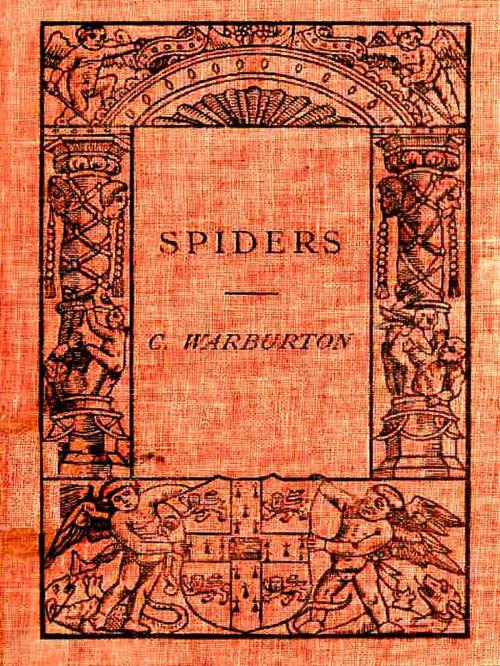| Author: | Cecil Warburton | ISBN: | 1230000208148 |
| Publisher: | VolumesOfValue | Publication: | January 9, 2014 |
| Imprint: | Language: | English |
| Author: | Cecil Warburton |
| ISBN: | 1230000208148 |
| Publisher: | VolumesOfValue |
| Publication: | January 9, 2014 |
| Imprint: | |
| Language: | English |
This edition features
• illustrations
• a linked Table of Contents and Index
CONTENTS
I.
A Survey of the Field. Evidences of spider industry. Where to look for spiders. Variety of habits
II.
What is a Spider? The Arthropoda and their divisions. Arachnida. Characteristics of a spider. Spinnerets and their use
III.
The Circular Snare. Foundation lines. The spiral with its viscid beads. The building of the snare. Why the spider is not caught in its own snare
IV.
The Mental Powers of Spiders. The human standpoint. Instinct. Sight. Hearing. Smell. Taste. Memory and “educability”
V.
Trap-snares and Balloons. Variations of the circular snare. The snare of Hyptiotes. Webs of Theridion and Linyphia. The iron railing and its aeronauts. A race congress. Gossamer. Geographical distribution
VI.
Agelena. Its web. The spider and its behaviour in captivity. The platform and its carpet. The construction of the cocoon. Instinctive, not intelligent
VII.
Water-Spiders. Marine spiders. The fresh-water spider. The diving bell, and how it is filled with air. Behaviour of the male. Winter and summer houses
VIII.
Crab-Spiders.—Mimicry. The appearance of crab-spiders. Their haunts. Protective coloration and resemblance. Habits correlated with structure. Probable origin of “mimicry”
IX.
Wolf-Spiders. General habits. Semi-aquatic species. Nomads and settlers. Structure. Eyes. Lycosa picta. A colony in full swing. The burrow. Egg-bags. Recognition of cocoons. Want of discrimination. The Tarantula. Its haunts and habits. The death-stroke. The burrow and its parapet. Sunning the cocoon. Carrying the young. Poisonous properties
X.
Jumping Spiders. The Zebra Spider. Its structure. Its wonderful eyes. Hunting its prey. The use of the drag-line. Sight in jumping spiders. Love dances. Sham-fights. A remarkable piece of research
XI.
Theraphosid Spiders. Sub-division of the Order. Mandibles. Atypus and its nest. Its habits. Aviculariidae. A giant spider. Trap-door nests. Method of burrowing. “Bird-eaters,” and their habits. Dugesiella. Poor sight but remarkable sense of touch. Psalmopoeus in captivity
XII.
Stridulation. How sound is produced in Arthropoda. Its purposes. Popular mistakes. Spines and Keys. The purring spider
XIII.
The Spinning Apparatus. Spinnerets. Their mobility. Spools and spigots. Glands. Arrangement in Epeira. No interweaving of lines. Functions of glands. Spinning operations. The Cribellum. The feet of spiders
XIV.
The Enemies of Spiders. Cannibalism. Egg parasites. Moulting. Starvation. Body parasites. Solitary wasps. A gruesome fate
XV.
Concluding Reflexions. The “use” of spiders. Wide range of habits. Complexity of instincts. The mystery of the egg. The storage of energy. Economy in diet. Conclusion
Literature
Index
This edition features
• illustrations
• a linked Table of Contents and Index
CONTENTS
I.
A Survey of the Field. Evidences of spider industry. Where to look for spiders. Variety of habits
II.
What is a Spider? The Arthropoda and their divisions. Arachnida. Characteristics of a spider. Spinnerets and their use
III.
The Circular Snare. Foundation lines. The spiral with its viscid beads. The building of the snare. Why the spider is not caught in its own snare
IV.
The Mental Powers of Spiders. The human standpoint. Instinct. Sight. Hearing. Smell. Taste. Memory and “educability”
V.
Trap-snares and Balloons. Variations of the circular snare. The snare of Hyptiotes. Webs of Theridion and Linyphia. The iron railing and its aeronauts. A race congress. Gossamer. Geographical distribution
VI.
Agelena. Its web. The spider and its behaviour in captivity. The platform and its carpet. The construction of the cocoon. Instinctive, not intelligent
VII.
Water-Spiders. Marine spiders. The fresh-water spider. The diving bell, and how it is filled with air. Behaviour of the male. Winter and summer houses
VIII.
Crab-Spiders.—Mimicry. The appearance of crab-spiders. Their haunts. Protective coloration and resemblance. Habits correlated with structure. Probable origin of “mimicry”
IX.
Wolf-Spiders. General habits. Semi-aquatic species. Nomads and settlers. Structure. Eyes. Lycosa picta. A colony in full swing. The burrow. Egg-bags. Recognition of cocoons. Want of discrimination. The Tarantula. Its haunts and habits. The death-stroke. The burrow and its parapet. Sunning the cocoon. Carrying the young. Poisonous properties
X.
Jumping Spiders. The Zebra Spider. Its structure. Its wonderful eyes. Hunting its prey. The use of the drag-line. Sight in jumping spiders. Love dances. Sham-fights. A remarkable piece of research
XI.
Theraphosid Spiders. Sub-division of the Order. Mandibles. Atypus and its nest. Its habits. Aviculariidae. A giant spider. Trap-door nests. Method of burrowing. “Bird-eaters,” and their habits. Dugesiella. Poor sight but remarkable sense of touch. Psalmopoeus in captivity
XII.
Stridulation. How sound is produced in Arthropoda. Its purposes. Popular mistakes. Spines and Keys. The purring spider
XIII.
The Spinning Apparatus. Spinnerets. Their mobility. Spools and spigots. Glands. Arrangement in Epeira. No interweaving of lines. Functions of glands. Spinning operations. The Cribellum. The feet of spiders
XIV.
The Enemies of Spiders. Cannibalism. Egg parasites. Moulting. Starvation. Body parasites. Solitary wasps. A gruesome fate
XV.
Concluding Reflexions. The “use” of spiders. Wide range of habits. Complexity of instincts. The mystery of the egg. The storage of energy. Economy in diet. Conclusion
Literature
Index















